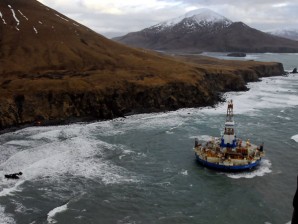Salvagers tight-lipped on Shell vessel recovery

Two life rafts sit on the beach adjacent as the conical drilling unit Kulluk sits grounded 40 miles southwest of Kodiak City, Alaska in this January 3 file photo. AP/US Coast Guard
ANCHORAGE, Alaska—The united command overseeing the salvage of the Royal Dutch Shell PLC drill barge that ran aground on a remote Alaska island will release minimal information on the vessel until an assessment is completed, a spokeswoman said.
Shell’s drill vessel Kulluk ran aground New Year’s Eve on the southeast side of Sitkalidak Island near Kodiak Island. On January 6, it was pulled off the rocky bottom and towed a day later to protected waters in Kiliuda Bay within Kodiak Island.
The operation is under the direction of a unified command structure made up of Shell, the Coast Guard, the Alaska Department of Environmental Conservation and the Kodiak Island Borough. The unified command has acknowledged that the vessel remains upright, has not leaked fuel and has been examined by divers, but not much else.
“I know you’re looking for specific answers but we wanted to let you know that due to the fact that multiple entities are involved in the assessment of data, including Unified Command, Shell, Smit Salvage and Det Norske Veritas, Unified Command will not comment on the assessment until the report is finalized,” said spokeswoman Deb Sawyer by email in response to questions about the operation. She did not provide a timetable for when the report would be done.
Smit Salvage is a Holland-based salvage company. Norway-based Det Norske Veritas inspects and evaluates the condition of vessels.
Article continues after this advertisementAfter Associated Press requests for additional information, the unified command said in a statement Friday night that a total of 12 divers and one remotely operated vehicle were used during the assessment of the barge in Kiliuda Bay.
Article continues after this advertisementThe data-gathering phase of the assessment has been completed, the latest statement said.
The Kulluk’s fuel tanks are intact and the damage found is “consistent with what is expected from a vessel of this type being on hard ground,” according to the latest update.
Water entered some spaces on the vessel through damaged hatches but it has been captured and stored in a compartment, the unified command said. Windows and hatches that could allow water to enter are being sealed and tow brackets are being added in preparation for the vessel’s next move.
The unified command said earlier that 250 people are in the Kodiak area as part of the effort and future plans for the Kulluk will be determined once a report is finished.
The command structure has declined to answer questions on what kind of data was collected, what inspectors might be looking for and whether anomalies have been detected.
The command structure also declined to say whether the inspection involves investigation of the vessel from the inside. No more details have been released regarding Kulluk generators that were knocked out or damage from seawater that entered through hatches that should have been sealed.
The Kulluk was built in 1983 for a Canadian company and purchased by Shell in 2005. The 266-foot (81-meter)-diameter vessel drilled last year in the Beaufort Sea off Alaska’s north coast. Its funnel-shape, reinforced hull is designed to deflect and break up moving ice, allowing it to drill beyond the short open water season.
The anchor handler Aiviq was towing the Kulluk to Seattle when the vessels ran into trouble in rough Gulf of Alaska water.
A tow line snapped Dec. 27 and a day later all four engines on the Aiviq failed, possibly due to contaminated fuel. The vessel’s crew eventually regained power but four subsequent tow lines attached to the Aiviq or other vessels also failed before the grounding.
The unified command has said the Kulluk will not be moved before the end of Kodiak’s tanner crab fishing season, which opened Wednesday and usually takes four to six days, said state shellfish management biologist Mark Stichert. Predicted bad weather may delay fishermen catching the quota of 520,000 pounds (235,870.45 kilograms), he said.